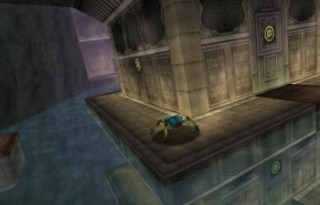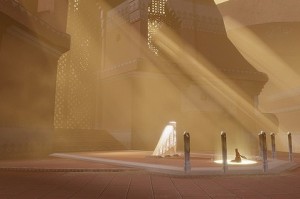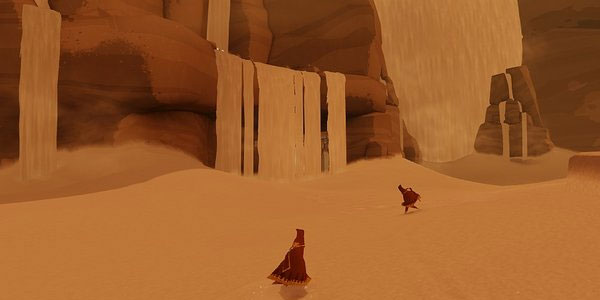What The Legend of Zelda Has to Learn from Journey
Posted on May 25 2012 by Legacy Staff
 Following the tremendous critical acclaim of Flower, its developer Thatgamecompany released Journey as a PlayStation Network exclusive earlier this year. Almost immediately, Journey was met with an even greater degree of critical acclaim, with many reviewers praising the game as a must-play experience. Having played the game myself, I agree entirely with the praise.
Following the tremendous critical acclaim of Flower, its developer Thatgamecompany released Journey as a PlayStation Network exclusive earlier this year. Almost immediately, Journey was met with an even greater degree of critical acclaim, with many reviewers praising the game as a must-play experience. Having played the game myself, I agree entirely with the praise.
Journey‘s gameplay amounts to one thing: movement. There is no combat, there is very limited puzzle solving (and the puzzles all revolve around moving forward), and there are no sidequests in the conventional sense. Your sole directive is to explore, to travel toward the mountain in the distance. The story is equally minimalist – with the exception of the 10 hidden ancient glyphs scattered throughout the path, you are thrust into a world gone by with little explanation of what happened or why it happened. Again, the driving factor of the story is to travel to the mountain.
The game is beautiful. The music and visuals are both emotionally affecting in their own right to a degree that few games these days are. As I returned for repeat Journeys with new companions multiple times, I began to realize that this purity of experience was something at which the Zelda series used to excel. In the original Legend of Zelda, you’re dropped into a world, handed a sword (after all, it’s dangerous to go alone), and let loose. You can explore the world or dive into the main quest and traverse the labyrinths. You can learn as much of the story as you choose, or as little. It’s an experience motivated entirely by the sense of exploration.
Modern Zelda titles have moved away from that, offering an (admittedly excellent) enveloping story that takes center stage, and often leaving exploration in the background. I realized then that the Zelda series has a lot to learn — or, rather, relearn — from Journey.
Exploration as Gameplay
Journey‘s gameplay is strangely compelling in that it asks you only to explore, as I’ve said. With no extended goals to deter you from just taking in the sights and enjoying the world, it makes the task far more central to the experience. In a sense, the original Legend of Zelda managed this feat as well. The labyrinths and the defeat of Ganon were the main “plot”, but it was never forced upon you. You would be completely validated if you chose to simply explore the world, kill monsters, buy stuff, upgrade your sword, and so on. The plot never pushed you in any direction. You were never compelled to progress in a certain order. You were completely and utterly free to take in this world however you wished.
Modern Zelda, however, has lost this feel. As recent articles have mentioned, Zelda games are taking longer to take off the training wheels. You enter this world, and are immediately beset with plot. Thick layers of it are poured upon you, and you are never left without an immediately pressing task. You have to deliver soup to somebody, you have to meet Zelda at the ceremony, you have to herd goats — a bunch of tasks that, while they push you into the world, do not allow you to experience it as you want to experience it. The world may be open to you, but you’re always pushed in a certain direction. Moreover, exploration is not rewarded in many cases: Both Twilight Princess and Skyward Sword had expansive worlds, but were more or less empty. The islands in the sky of Skyward Sword rarely contained more than a simple treasure chest, and Hyrule Field in Twilight Princess was little more than a… field. You could explore these places, but there was little motivation to do so.
 What Zelda should take from Journey‘s example is that exploration should be one of the primary points of gameplay. The two best ways to do that are to expand the rewards inherent in exploring, and to modify the design of dungeons. As it stands, there are already several rewards the series grants explorers — namely, Pieces of Heart and collectibles like the Golden Bugs. The problem with this design is that it is entirely feasible to skip over these rewards entirely, and still finish the game with little to no difficulty. As such, any exploration will invariably feel like time wasted unless your sole goal is to acquire everything you possibly can. Exploration is thus only incentivized for players who like to feel they have done everything they can. A way to remedy this would be to include significant incentives given for exploring and solving puzzles in the open. For example, things like the Magic Armor, rather than coming from a mini-game or gathering quest, could be found in the world at the end of a series of (outdoor) puzzles. Anything that would significantly aid players in their quest would be welcome. An alternative would be to simply make the game considerably difficult without the collectibles, but that has the adverse effect of punishing players for not exploring rather than making them feel rewarded for doing so.
What Zelda should take from Journey‘s example is that exploration should be one of the primary points of gameplay. The two best ways to do that are to expand the rewards inherent in exploring, and to modify the design of dungeons. As it stands, there are already several rewards the series grants explorers — namely, Pieces of Heart and collectibles like the Golden Bugs. The problem with this design is that it is entirely feasible to skip over these rewards entirely, and still finish the game with little to no difficulty. As such, any exploration will invariably feel like time wasted unless your sole goal is to acquire everything you possibly can. Exploration is thus only incentivized for players who like to feel they have done everything they can. A way to remedy this would be to include significant incentives given for exploring and solving puzzles in the open. For example, things like the Magic Armor, rather than coming from a mini-game or gathering quest, could be found in the world at the end of a series of (outdoor) puzzles. Anything that would significantly aid players in their quest would be welcome. An alternative would be to simply make the game considerably difficult without the collectibles, but that has the adverse effect of punishing players for not exploring rather than making them feel rewarded for doing so.
The other possibility is to mix up dungeon design. When I say this, I don’t mean the environmental and artistic design of the dungeons; In almost every case, these are stellar and make the player want to explore them of their own merits. The problem with that is that dungeons are designed almost as straight lines with a very set path through them: Find the Dungeon Map, the Compass, fight a mini-boss, get the item, get the Big Key, kill the boss. That’s worked well for the series thus far, but it often leads to the dungeons feeling like a long series of puzzles rather than a sacred place of worship or the hollowed inside of a giant tree — like the actual area they are supposed to be. The way that the developers could encourage exploration within dungeons is to discard this formula entirely and remove all the training wheels; Toss players in this structure and let them find their way through. Though many may hate to hear this, the best example of this that comes to mind is the infamous Water Temple from Ocarina of Time. It was massive and directionless. You were presented with a myriad of passageways to explore with no indicators of which ones you should explore to progress further. By the end of that dungeon, you’d probably been to every room at least twice and memorized the layout. If I were to say, “that one room with a whirlpool and the grate”, I’m sure almost everybody is picturing it vividly. It forced you to explore because it didn’t hold your hand.
Zelda could benefit from these changes, and indeed the developers seem to be experimenting. The Sky Keep in Skyward Sword was one of the best-designed dungeons in the series thus far by my vote. Your map was almost useless as the rooms shuffled according to a sliding puzzle that you controlled. You had to get by on your own sense of direction, and that was novel, exciting, and engaging. That is the feel that should be captured throughout the entire game.
Exploration as Storytelling
 I’ve praised the storytelling of Zelda several times in the past, and I stand by that praise; The series does a great job at conveying its story. The problem is that it’s beginning to show some signs of its age. There are debates raging at this very moment about whether or not there should be voice acting in Zelda games, with many of the arguers for voice acting noting that it’s become almost an industry standard, one that Nintendo has yet to fully embrace. The stories of the games have become increasingly complex and long-winded, with some dialogue sequences taking around 15 minutes to play out. There’s a lot of story to be told, and that’s fine. The problem lies in that story being too large for the way Zelda tells it.
I’ve praised the storytelling of Zelda several times in the past, and I stand by that praise; The series does a great job at conveying its story. The problem is that it’s beginning to show some signs of its age. There are debates raging at this very moment about whether or not there should be voice acting in Zelda games, with many of the arguers for voice acting noting that it’s become almost an industry standard, one that Nintendo has yet to fully embrace. The stories of the games have become increasingly complex and long-winded, with some dialogue sequences taking around 15 minutes to play out. There’s a lot of story to be told, and that’s fine. The problem lies in that story being too large for the way Zelda tells it.
Journey had no such problem. Journey is undoubtedly an epic, and has a great sense of backstory. The robed creatures, one of which you control, were a once great civilization and eventually built grand temples and cities across the world. Eventually, they ran afoul of a race of mechanical worms from underneath the earth, and nearly their entire race was wiped out. You play as one of the last remaining robed creatures as you journey toward the mountain in the distance.
That’s a fair amount of backstory, but the mind-blowing part is that it was all conveyed without the aid of dialogue or even descriptive text. It was conveyed entirely through Ancient Glyphs, small monuments that survived the world’s apparent destruction, that when activated revealed a scene of history. When connected, the glyphs told the above story through the images they displayed. How did they manage to cram all this story into a two hour game?
Simple: The story was revealed through exploration. It never forced this story down your throat or made you sit through lengthy dialogue sequences. You were free to take in the story as you saw fit, and to explore motivated by whatever you pleased. This is why the story worked so well in Journey; Your experience with the story was determined entirely by how intrigued you were. The Legend of Zelda did this very well, with almost no story being revealed through the game, and with most of the story available through supplemental materials (such as the instruction manual).
Modern Zelda titles should make great efforts to make it so much of the story is available solely through exploring. This isn’t to say that the game should be directionless, but it should be far more in the vein of the original game than the latter games. A quick introduction and a point in the right direction — “It’s dangerous to go alone!” — as opposed to a lengthy two hour introduction (or longer) as seen in the Skyward Sword opening sequences. After that initial kick, players should be free to explore and experience the story of the game as they see fit. Do they want to learn about the backstory of the current events (or the land in which they are adventuring, if it isn’t Hyrule)? That’s an option. Would they rather proceed straight through the main story with no regard for the past? That’s an option. Would they like to experience both at the same time? That’s an option. Every player is free to pursue the story of the game as they see fit.
Subtle storytelling such as that seen in Journey is a powerful tool, one from which I feel Zelda could greatly benefit. A world with such a rich personality as Termina could be expanded upon by exploring its environs, finding bits of story hidden everywhere and delving into the backstory of the world. The sense of mystery that made Termina so great could easily be preserved with this method, while also greatly increasing our understanding of the mysterious events that occurred there.
Oh, and one final note on story: In a previous article, I outlined the ways that Zelda games tell the archetypal Hero’s Journey. Journey, as you might expect, very deliberately does this as well, and in a stroke of pure brilliance, all of the songs on the official soundtrack are named according to the stages of the Hero’s Journey.
Closing Thoughts
Journey is a spectacular game, and one that everybody should experience. It bears a number of similarities to classic Zelda games, where exploration and the sense of adventure that Miyamoto intended to capture were paramount to the puzzles and combat which dominate the series today. The question that remains, and it is one that will likely be hotly debated, is simple: Should Zelda return to the exploration based gameplay that dominated its early years, or continue its modern, highly story driven style?
My experiences in Journey make the answer a very clear one for me: Exploration as gameplay and as storytelling is by far the purest adventure experience, one that I miss with all my heart.




